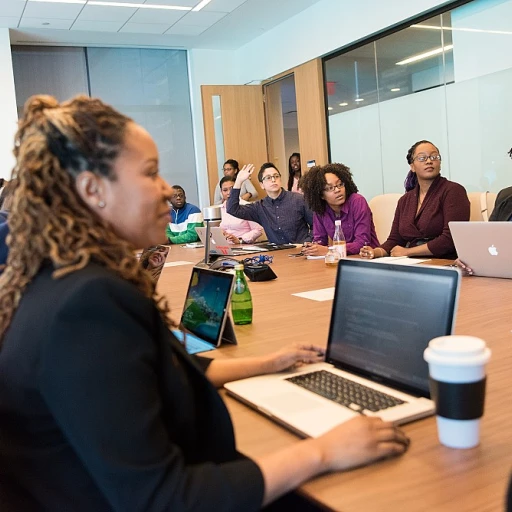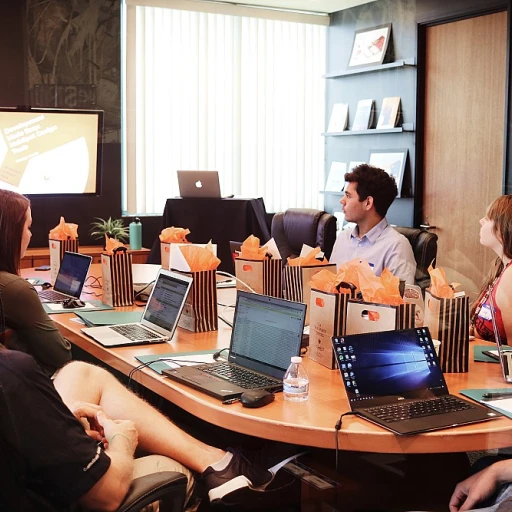
Understanding Talent Mobility
Exploring the Concept of Workforce Fluidity
In today’s fast-paced business environment, understanding the intricacies of talent mobility is crucial for organizational success. Talent mobility refers to the movement of employees within an organization to different roles or opportunities, aligning their skills with the ever-changing business needs. This dynamic concept not only helps in bridging skill gaps but also fosters continuous learning and career development among the workforce.
Talent mobility programs are designed to enhance workforce agility by providing employees with internal opportunities that match their career aspirations and skills. It is a strategic approach that empowers employees to evolve in their roles, thus driving engagement and retention. The process enables companies to retain top talent by creating pathways for internal career growth and development, mitigating the risk of losing valuable skills to competitors.
Moreover, talent mobility supports internal talent management by ensuring that the right employees move into roles where they can be most effective. By doing so, organizations can better leverage their internal resources, reducing the need for external hiring and promoting a culture of internal advancement. This strategy also plays a pivotal role in aligning employee roles with company objectives, supporting both personal and business growth in the long term.
As companies implement mobility strategies, they must consider the various factors that contribute to an effective talent marketplace. These include identifying skill gaps, developing robust mobility programs, and ensuring that employees have access to continuous learning opportunities. By focusing on employee development across various roles, organizations can foster a more adaptable and resilient workforce.
The Role of a Chief Human Resources Officer
Navigating the Strategic Path for Talent and Opportunity
In the evolving landscape of human resources, the Chief Human Resources Officer (CHRO) plays a pivotal role in championing talent mobility within an organization. This dynamic process ensures that talent is effectively moved and developed internally, creating a robust framework for career development and workforce agility. The CHRO's responsibilities extend far beyond traditional HR roles, necessitating a deep understanding of both strategy and tactics in HR leadership. Talent mobility isn't just about transferring employees from one position to another; it involves cultivating an environment where skills are continuously developed and strategically aligned with both immediate and long-term business needs. Crafting and Executing Mobility Strategies A CHRO must craft internal mobility strategies that focus on identifying skills gaps within the organization. One effective strategy includes creating a talent marketplace where employees can explore diverse career paths and growth opportunities, enhancing employee engagement and retention. Fostering a Culture of Learning and Development Encouraging continuous learning and development is vital. It is the responsibility of the CHRO to embed a culture that values both formal and informal learning programs, enabling employees to expand their skillsets and adapt to new roles seamlessly. Program Implementation and Monitoring Effective talent mobility programs are meticulously planned and monitored. CHROs must oversee the development of these programs, ensuring they align with the organizational goals and adapt as the company grows. This includes tracking the progression of employees moving internally and assessing the impact of these moves on both the individual and the company. By integrating these facets, the CHRO not only helps in filling roles but also in developing a thriving organizational ecosystem where talent and business objectives are harmoniously aligned, driving overall success.Strategies for Implementing Talent Mobility
Implementing Effective Talent Mobility Strategies
To ensure successful deployment of talent mobility within an organization, it is crucial to have a well-defined strategy in place. This involves several key elements that help drive internal mobility and foster continuous career development among employees. Here are some strategies that companies can adopt:
- Create a Talent Marketplace: Establishing a transparent talent marketplace within the organization allows employees to explore and apply for internal job opportunities. This platform should showcase available roles, required skills, and potential career paths, enabling employees to take proactive steps in their career journeys.
- Emphasize Continuous Learning and Development: Encouraging a culture of learning is vital for closing skills gaps. Companies can offer various learning development opportunities such as workshops, online courses, and mentorship programs to enhance employee skills and prepare them for future roles.
- Design a Comprehensive Mobility Program: Develop structured mobility programs that outline the process for employees interested in moving to different roles. These programs should include criteria for eligibility, support mechanisms, and clear guidelines that assist employees in navigating their internal career paths.
- Promote Internal Talent Management: Effective talent management practices help identify top talent and create meaningful opportunities for them within the organization. It is important to align talent management with business goals to ensure that key roles are filled by capable individuals.
- Utilize Data-Driven Insights: Leveraging technology to gather data and insights on employee skills and performance can guide mobility strategies. This data can identify potential skill gaps and employees who are ready for new opportunities, facilitating a more strategic approach to mobility.
- Encourage Employee Engagement: Engaged employees are more likely to embrace mobility opportunities. Cultivating a supportive environment where employees feel valued and motivated will enhance their willingness to pursue new roles and contribute to long-term organizational success.
Implementing these strategies can empower an organization to not only retain but also effectively utilize its workforce in a way that aligns with business objectives. For more insights on enhancing HR leadership and effective service strategies, you can visit our detailed guide on the ADKAR framework.
Leveraging Technology for Talent Mobility
Integrating Modern Tools to Enhance Talent Insights
In the current business climate, leveraging technology in talent mobility is not just an option but a necessity. Innovative tools and platforms can help organizations streamline internal talent processes and improve decision-making. By utilizing data analytics and AI-driven solutions, companies can gain deeper insights into their workforce's skills and potential for growth. Incorporating a talent marketplace within an organization allows employees to explore various career paths and development opportunities internally. Such platforms enhance internal mobility by connecting employees with suitable roles that match their skill sets and aspirations, thereby fostering a culture of continuous learning and employee engagement.Facilitating Learning Development through Digital Platforms
Companies are increasingly turning to digital platforms to facilitate learning development. These platforms offer extensive learning resources and training modules that enable employees to build new skills and close skills gaps. By investing in these tools, organizations not only strengthen their workforce but also increase the chances of retaining top talent. A well-implemented learning development program can significantly impact talent mobility by empowering employees to take charge of their career development. This not only benefits the employees but also contributes to the company's long-term success by having a more versatile and agile workforce equipped to take on new challenges.Implementing Effective Talent Management Systems
Effective talent management systems are integral to promoting talent mobility within organizations. These systems help in tracking employee progress, assessing performance, and identifying potential leaders within the company. By keeping a pulse on employees' development, organizations can strategically guide their mobility programs and ensure that employees move into roles where they can thrive. Moreover, a cohesive talent management strategy ensures that there are structured career development paths for employees, supporting their growth along different business roles and functions. Such a strategy aligns with the overall goals of the company and contributes to building a resilient and adaptable workforce. Technology plays a critical role in talent mobility, significantly enhancing how organizations manage and develop their internal talent. By leveraging these modern tools effectively, companies can create a dynamic and fulfilling career environment that meets the evolving needs of their workforce and business objectives.Measuring the Impact of Talent Mobility
Evaluating Talent Mobility Initiatives
In order to ascertain the effectiveness of talent mobility, it is crucial for organizations to implement precise metrics and analytics. These metrics will help leaders understand how mobility initiatives are impacting overall workforce agility and development.- Tracking Skills Development: Monitoring the progression of skills is essential. By utilizing methods to track internal career development, companies can evaluate if employees are gaining new competencies that fulfill the skills gaps.
- Employee Engagement Levels: Assessing changes in employee engagement and satisfaction can reveal insights about the success of mobility programs. Engaged employees are more likely to take part in available mobility opportunities.
- Operational Efficiency: Gauge whether mobility initiatives are enhancing operational efficiency. This helps in identifying how internal talent is aiding the company’s goals by filling critical roles more swiftly and effectively.
- Career Advancement Rates: Analyzing the rate at which employees move to different positions within the organization can indicate if there are robust career paths integrated into the mobility strategy.
- Contribution to Business Goals: Finally, align mobility programs with the company's long-term strategy to ensure initiatives contribute to core business objectives, thus fostering effective talent management.
Case Studies: Success Stories in Talent Mobility
Real-World Examples of Talent Mobility Success
Exploring successful case studies can provide valuable insights into how organizations have effectively implemented talent mobility strategies. These examples highlight the transformative impact of internal mobility programs on workforce agility and employee engagement.
Global Tech Company: Building a Talent Marketplace
A leading global tech company implemented a comprehensive talent marketplace to address skills gaps and enhance career development opportunities. By leveraging technology, they created a platform where employees could explore new roles and career paths within the organization. This initiative not only helped retain top talent but also fostered continuous learning and development. The company reported a significant increase in employee satisfaction and a reduction in turnover rates.
Financial Services Firm: Strategic Internal Mobility
A prominent financial services firm adopted a strategic approach to internal mobility by aligning their mobility programs with business goals. They focused on identifying and nurturing internal talent, enabling employees to move across different roles and departments. This strategy not only filled critical positions with skilled employees but also enhanced the company's ability to adapt to changing market demands. As a result, the firm experienced improved business performance and a more agile workforce.
Healthcare Organization: Enhancing Employee Engagement
In the healthcare sector, a large organization implemented a mobility strategy aimed at boosting employee engagement and career development. By offering structured learning development programs and clear career paths, they empowered employees to take charge of their career growth. This approach not only helped bridge skills gaps but also increased employee loyalty and motivation. The organization saw a marked improvement in patient care quality, driven by a more engaged and skilled workforce.
Retail Giant: Fostering Long-Term Growth
A major retail company focused on long-term growth by creating a robust internal mobility program. They emphasized the importance of effective talent management and provided opportunities for employees to explore different roles within the company. This initiative led to a more versatile workforce, capable of adapting to new challenges and driving business success. The company reported enhanced employee retention and a stronger alignment between individual career aspirations and organizational objectives.
These case studies demonstrate that a well-executed talent mobility strategy can significantly benefit both employees and organizations. By fostering a culture of internal mobility, companies can unlock new opportunities for growth and ensure their workforce remains agile and competitive in an ever-evolving business landscape.












